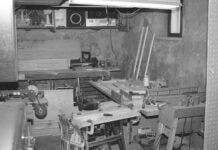Why would a new guy offer advice about how to set up a shop? First of all, I just set up a new shop. Second, I have a fresh memory for the details of what drove me nuts. Third, I remember what wasted a lot of my time and money.
No matter where you are building—a garage, airport hangar, or even a New York City studio apartment, you need a place to call your shop. A well-organized and well-equipped shop is crucial to make your builder’s journey enjoyable. You can waste a lot of money and still be frustrated by not having what you want when you need it.
Even though you will be overwhelmed with advice from both friends and the Internet on how to set up shop, here is a streamlined list to get you started.
Well-Equipped
• No matter what kind of plane you are building, you will need some basic woodworking tools. You will be building things like plans holders, workbenches, shelves, jigs, storage boxes, shipping boxes, and paint stands.
• The drill press, bandsaw, and belt sander are pretty much the trifecta of shop power tools. For the belt sander, some guys like the 1-inch belt. I prefer 3 inches. Most belt sanders have a disc, too.
• Build your own workbench: EAA 1000 has plans at www.eaa1000.av.org/technicl/worktabl/tablefig.htm.
• Plan on putting drop-by helpers to work. Buy some extra Cleco pliers; they are inexpensive. So are spare safety glasses, sanding blocks, Scotch-Brite pads, and extra deburring tools. By the way, cat-litter jugs make great Cleco holders.
• Brushes, mops, brooms, and a shop vacuum are also part of the tool set you need for your shop. Mr. Bradshaw, my junior high school shop teacher, tried to teach me never to brush metal shavings off a workbench with my hands. Well, I finally learned. From now on, I’ll never brush metal cuttings off the table with my hands again. Which leads to:
• Get a good first aid kit. Be sure it has tweezers. If you have not had a tetanus shot in the last 10 years, get one. Liquid hand sanitizer is a good idea, too.
• Buy a good air compressor; it is worth the money. If you can support 220 volts, go that way. Be careful of used compressors, especially older ones. Unless the tank was drained every day, there may be internal rust you cannot see.
• Keep a cup full of Sharpies for marking aluminum and steel. Get different sizes and different colors, too.
Well-Organized
• Baby food jars are great for holding small parts and rivets. Ask your friends with babies to save a bunch for you. You might also ask at a local day-care center. Just ask around and you will be amazed how many babies there are.
• Get a cabinet to store chemicals. Lots of project chemicals are pretty toxic and should be kept away from kids and flames. You should keep old flames out of the shop anyway.
• Prepare for parts that are finished, but not accessed, for a long period of time. You will need to safely store completed components to prevent hangar rash and to keep your work area organized. High-up shelving that requires little access will be OK for these items. Be prepared to store stuff in unconventional places.
• Get a basic collection of aircraft-grade nuts, bolts, and washers. Place them in well-marked containers with easy access. AN/MS hardware at your fingertips will help when the plans say you need an AN3-4, but you really need an AN3-5. (Note: Aircraft-grade hardware should be clearly marked and separated from hardware-store nuts and bolts. You never want to confuse the two.)
Building should be enjoyable and rewarding with a minimum of frustration and roadblocks. It is why we are building Experimental airplanes in the first place. Your shop can make a world of difference in the process.
Build On!

















